Top Rankings
Magnolia Elementary School District ranks among the top 20% of public school district in California for:
Category
Attribute
Community Size
Largest student body (number of students) (Top 1%)
For the 2025 school year, there are 9 public elementary schools serving 4,917 students in Magnolia Elementary School District. This district's average elementary testing ranking is 7/10, which is in the top 50% of public elementary schools in California.
Public Elementary Schools in Magnolia Elementary School District have an average math proficiency score of 39% (versus the California public elementary school average of 35%), and reading proficiency score of 48% (versus the 45% statewide average).
Minority enrollment is 92% of the student body (majority Hispanic), which is more than the California public elementary school average of 79% (majority Hispanic).
Overview
This School District
This State (CA)
# Schools
9 Schools
7,700 Schools
# Students
4,917 Students
3,822,920 Students
# Teachers
233 Teachers
174,000 Teachers
Student : Teacher Ratio
21:1
21:1
District Rank
Magnolia Elementary School District, which is ranked #631 of all 1,925 school districts in California (based off of combined math and reading proficiency testing data) for the 2021-2022 school year.
Overall District Rank
#629 out of 1941 school districts
(Top 50%)
(Top 50%)
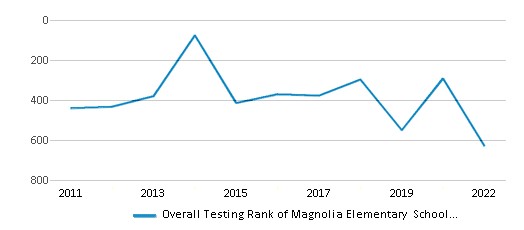
Math Test Scores (% Proficient)
39%
33%

Reading/Language Arts Test Scores (% Proficient)
47%
47%
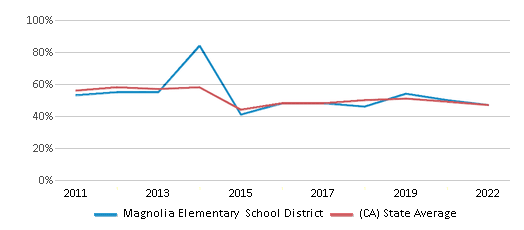
Science Test Scores (% Proficient)
29%
29%
Students by Ethnicity:
Diversity Score
0.49
0.64
# American Indian Students
17 Students
16,785 Students
% American Indian Students
n/a
1%
# Asian Students
739 Students
454,357 Students
% Asian Students
15%
12%
# Hispanic Students
3,432 Students
2,114,366 Students
% Hispanic Students
70%
55%
# Black Students
163 Students
189,461 Students
% Black Students
3%
5%
# White Students
392 Students
787,389 Students
% White Students
8%
21%
# Hawaiian Students
35 Students
15,077 Students
% Hawaiian Students
1%
n/a
# Two or more races Students
139 Students
240,557 Students
% of Two or more races Students
3%
6%
Students by Grade:
# Students in PK Grade:
-
83
# Students in K Grade:
901
519,574
# Students in 1st Grade:
639
396,601
# Students in 2nd Grade:
666
414,466
# Students in 3rd Grade:
673
416,628
# Students in 4th Grade:
618
426,360
# Students in 5th Grade:
677
430,582
# Students in 6th Grade:
743
432,936
# Students in 7th Grade:
-
312,207
# Students in 8th Grade:
-
312,649
# Students in 9th Grade:
-
44,929
# Students in 10th Grade:
-
37,487
# Students in 11th Grade:
-
37,249
# Students in 12th Grade:
-
41,169
# Ungraded Students:
-
-
District Revenue and Spending
The revenue/student of $20,802 is higher than the state median of $19,974. The school district revenue/student has grown by 9% over four school years.
The school district's spending/student of $16,902 is less than the state median of $18,396. The school district spending/student has grown by 9% over four school years.
Total Revenue
$102 MM
$116,387 MM
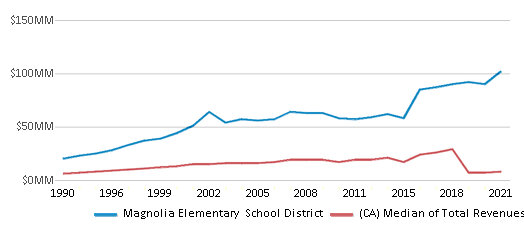
Spending
$83 MM
$107,188 MM
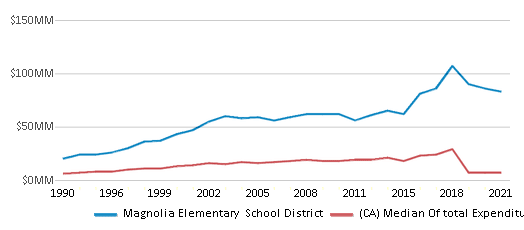
Revenue / Student
$20,802
$19,974
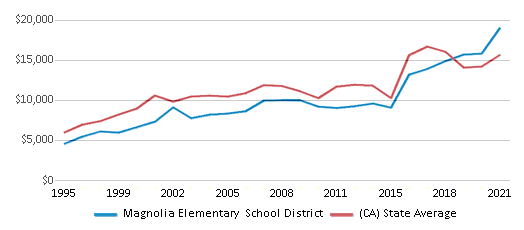
Spending / Student
$16,902
$18,396
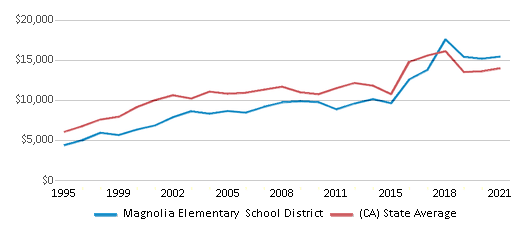
Best Magnolia Elementary School District Public Elementary Schools (2025)
School
(Math and Reading Proficiency)
(Math and Reading Proficiency)
Location
Grades
Students
Rank: #11.
Dr. Peter Marshall
(Math: 54% | Reading: 60%)
Rank:
Rank:
9/
Top 20%10
2627 Crescent Ave.
Anaheim, CA 92801
(714) 527-8821
Anaheim, CA 92801
(714) 527-8821
Grades: K-6
| 718 students
Rank: #22.
Walt Disney
(Math: 52% | Reading: 61%)
Rank:
Rank:
9/
Top 20%10
2323 West Orange Ave.
Anaheim, CA 92804
(714) 535-1183
Anaheim, CA 92804
(714) 535-1183
Grades: K-6
| 552 students
Rank: #33.
Dr. Albert Schweitzer Leadership Academy
(Math: 43% | Reading: 54%)
Rank:
Rank:
8/
Top 30%10
229 South Dale Ave.
Anaheim, CA 92804
(714) 527-7761
Anaheim, CA 92804
(714) 527-7761
Grades: K-6
| 513 students
Rank: #44.
Juliette Low School Of The Arts
(Math: 37% | Reading: 45%)
Rank:
Rank:
7/
Top 50%10
215 North Ventura
Anaheim, CA 92801
(714) 533-2673
Anaheim, CA 92801
(714) 533-2673
Grades: K-6
| 469 students
Rank: #55.
Lord Baden-powell
(Math: 30% | Reading: 49%)
Rank:
Rank:
6/
Top 50%10
2911 Stonybrook Dr.
Anaheim, CA 92804
(714) 761-5442
Anaheim, CA 92804
(714) 761-5442
Grades: K-6
| 288 students
Rank: #66.
Dr. Jonas E. Salk
(Math: 36% | Reading: 40%)
Rank:
Rank:
6/
Top 50%10
1411 South Gilbert St.
Anaheim, CA 92804
(714) 527-5143
Anaheim, CA 92804
(714) 527-5143
Grades: K-6
| 680 students
Rank: #77.
Robert M. Pyles Stem Academy
(Math: 30% | Reading: 44%)
Rank:
Rank:
6/
Top 50%10
10411 South Dale St.
Stanton, CA 90680
(714) 761-6324
Stanton, CA 90680
(714) 761-6324
Grades: K-6
| 647 students
Rank: #88.
Esther L. Walter
(Math: 34% | Reading: 38%)
Rank:
Rank:
6/
Top 50%10
10802 Rustic Ln.
Anaheim, CA 92804
(714) 761-5997
Anaheim, CA 92804
(714) 761-5997
Grades: K-6
| 459 students
Rank: #99.
Mattie Lou Maxwell
(Math: 29% | Reading: 37%)
Rank:
Rank:
5/
Bottom 50%10
2613 West Orange Ave.
Anaheim, CA 92804
(714) 527-2217
Anaheim, CA 92804
(714) 527-2217
Grades: K-6
| 591 students
Recent Articles

What Is A Charter School?
Explore the world of charter schools in this comprehensive guide. Learn about their history, how they operate, and the pros and cons of this educational innovation. Discover key facts about charter schools, including admission policies, demographics, and funding, as well as what to look for when considering a charter school for your child.

10 Reasons Why High School Sports Benefit Students
Discover the 10 compelling reasons why high school sports are beneficial for students. This comprehensive article explores how athletics enhance academic performance, foster personal growth, and develop crucial life skills. From improved fitness and time management to leadership development and community representation, learn why participating in high school sports can be a game-changer for students' overall success and well-being.

February 05, 2025
Understanding the U.S. Department of Education: Structure, Impact, and EvolutionWe explore how the Department of Education shapes American education, from its cabinet-level leadership to its impact on millions of students, written for general audiences seeking clarity on this vital institution.





